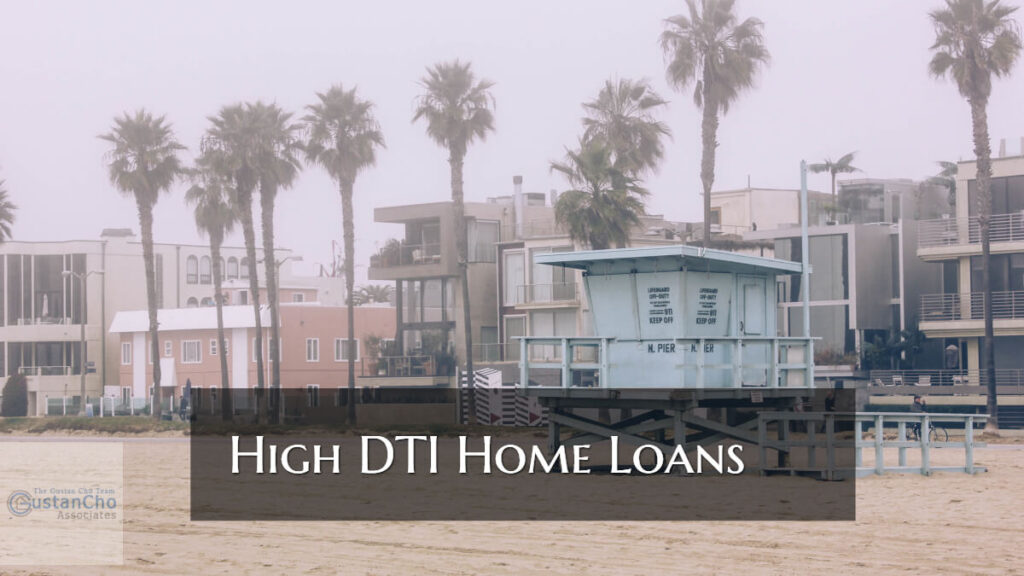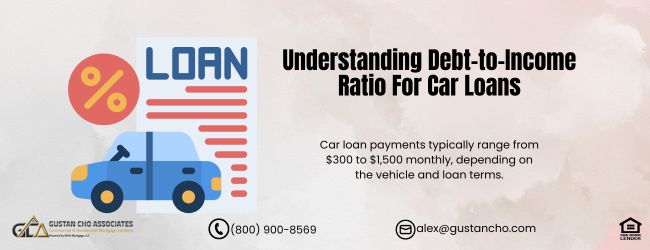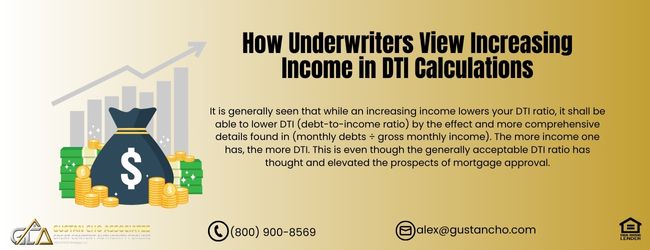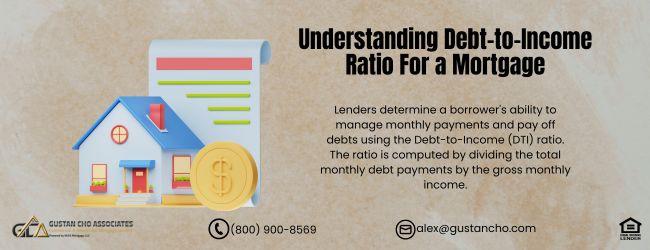Solutions For High Debt-to-Income Ratio Home Loans

This guide covers qualifying for a mortgage with high debt-to-income ratio home loans. Borrowers with high debt-to-income ratio is what a mortgage underwriter will determine whether or not a mortgage loan applicant qualifies. Mortgage underwriters are very leery of borrowers with high debt-to-income ratio.
Debt-to-income ratio determines the ability to repay the new mortgage payment. Having high debt-to-income ratio determines whether new homeowners can afford to make their new payments.
Debt-to-income ratio is calculated by taking the sum of the borrower’s monthly minimum debt payments which includes the proposed housing payment (principal, interest, taxes, insurance also known as PITI) and dividing it by borrower’s monthly gross income. That percentage is the debt-to-income ratio or DTI.
Reduce existing debt is another solution for high debt-to-income ratio. Focus on paying down high-interest debts to reduce your overall debt burden. This may involve prioritizing payments on credit cards, personal loans, or other high-interest debts.
What Are The Debt-to-Income Ratio Guidelines on Home Loans
Debt-t0-income ratio requirements differ depending on the loan program. Every loan program has its own debt-to-income ratio guidelines. Debt-to-income ratio depends on agency guidelines as well as lender overlays on FHA, USDA, VA, Conventional, and Jumbo loans. Non-QM loans and HELOCs or second mortgages has its own debt-to-income guidelines.
FHA loans have the most generous debt-to-income ratio caps than any other mortgage program Debt-to-income ratio caps for the front end is 46.9% and back end debt-to-income ratio is at 56.9% on FHA loans.
Conventional loans have a maximum 50% debt-to-income ratio cap. There is no front end DTI requirements on conventional loans. USDA Loans is capped at 29% front end and 41% back end debt-to-income ratio. VA does not have a maximum DTI requirement nor a minimum credit score require at Gustan Cho Associates. VA loans’ debt-to- income ratio caps depends on the findings of the Automated Underwriting System.
High Debt-to-Income Ratio Home Loans
California homebuyers will need more income to meet mortgage lending guidelines with regards of debt to income ratios.
California also has higher FHA and Conventional loan limits than other parts of the country. Maximum FHA loan limits for high-cost areas in California is substantially higher than the standard FHA loan limit of $489,257 in standard areas The maximum loan limit in high-cost areas depends on the area. The standard lending limit for FHA loans in average areas are capped at $489,257. FHA loan limit in high cost areas is capped at $1,149,825. Conventional loan limits in high-cost areas are$1.149,825 and the standard conventional loan limit in standard areas is $766.550.
Solution For High Debt-to-Income Ratio Improve Credit Score
A higher credit score can sometimes offset a higher debt-to-income ratio. Higher credit scores mean lower rates which will reduce your debt-to-income ratios. Focus on improving your credit by paying bills on time, reducing outstanding balances, and addressing any errors on your credit report. If possible, consider delaying your home purchase until you can improve your financial situation. This may give you time to pay down debts, increase your income, or save for a larger down payment. Increasing your down payment can sometimes help you qualify for a larger loan or improve your debt-to-income ratio. Consider saving more before applying for a home loan.
Solutions For High Debt-to-Income Ratio Exploring FHA Loans
FHA loans have the most generous debt-to-income ratio caps than any other mortgage loan program. Maximum front end debt-to-income ratio caps for FHA loans is 46.9% DTI. Maximum back end debt-to-income ratio caps on FHA loans is 56.9% DTI.
Investigate government-backed loan programs that may have more flexible requirements. FHA (Federal Housing Administration) loans often have more lenient criteria compared to conventional loans.
These ratios are for FHA home loan borrowers with credit scores of 620 FICO or higher. For borrowers with credit scores under 620 FICO, debt-to-income ratios are capped at 43%. Manual underwriting also caps debt-to-income ratios to 50% DTI with compensating factors.
Budgeting and Expense Reduction
Debt-to-income ratios on conventional loans is normally capped at 50% DTI. There is no front-end debt-to-income ratio requirements on conventional loans. Budgeting and expense reduction is yet another solution for high debt-to-income ratio. Create a detailed budget to track your income and expenses.
Identify areas where you can cut costs and redirect those funds toward debt repayment. This may involve cutting discretionary spending, renegotiating bills, or finding more affordable alternatives.
Debt consolidation is another solution for high debt-to-income ratio. Explore options for consolidating high-interest debts into a lower-interest loan. This can make it easier to manage payments and reduce the overall interest you pay.
Solutions To High Debt-to-Income Ratio By Refinancing Debt
If the borrower’s debt to income ratios exceeds the maximum allowed, there are a few solutions. Installment debt a mortgage loan borrower is not responsible can be exempt from calculating debt to income ratios. For example, here’s a case scenario when and if if a borrower’s parent is paying for the borrower’s student loans.
The student loan payments can be exempt from the borrower’s debt-to-income ratios if parents co-signed for the borrower.
To be exempt from debt-to-income ratio calculations, the borrower needs to provide the parent’s 12 months canceled checks that the parent has been making the student loan provider. Also, if a borrower is a co-signer on an auto loan or home loan to another person, that loan can be exempt if the borrower can provide they are not responsible for the payment. This can be done by providing 12 months canceled checks from the person making the actual payments.
Adding Non-Occupant Co-Borrowers To Qualify For Mortgage
Both Conventional and HUD allows non-occupant co-borrowers to be added on the mortgage loan of a borrower to qualify for income. Non-occupant co-borrowers needs to be related to the borrower by law, marriage, or blood on FHA loans. Non-occupant co-borrowers will go on the mortgage note but not on title to the property. With Conventional loans, non-occupant co-borrowers DO NOT have to be related.
If possible, consider having a co-signer with a lower debt-to-income ratio. This can strengthen your loan application, but keep in mind that the co-signer is taking on the responsibility for the loan as well.
Consult with a financial advisor or mortgage broker who can provide personalized advice based on your specific financial situation. Remember that it’s essential to communicate openly with potential lenders about your financial situation. They may be able to offer guidance and solutions based on their specific lending criteria. Keep in mind that the exact strategies that work for you will depend on your unique circumstances and the policies of the lender you’re working with.






To get an approve/eligible per automated underwriting system on FHA loans, you need a 46.9% front end and 56.9% back-end debt-to-income ratio.
Can you qualify for a mortgage loan with high debt-to-income ratio without co-borrower?
You need to meet the minimum debt to income ratio per agency guidelines. Or you can qualify for non-qm loans.
How do you fix high debt to income ratio so you can get approved for a mortgage.
Paying down debt is the most straightforward way to reduce your DTI. The fewer debts you owe, the lower your debt-to-income ratio will be. Suppose that you have a car loan with a monthly payment of $500. You can begin paying an extra $250 toward the principal each month to pay off the vehicle sooner